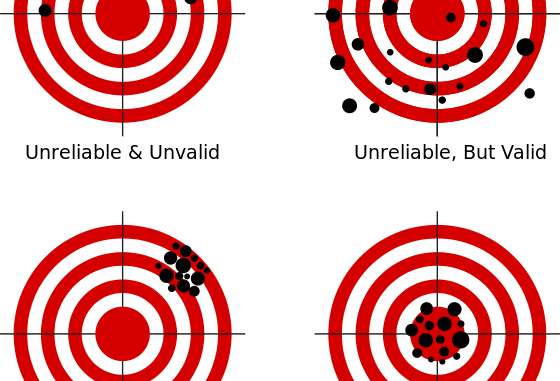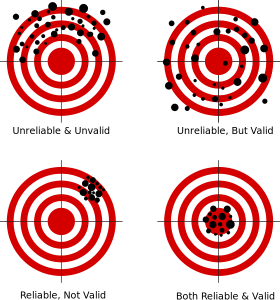
Here you have all the major differences between Validity and Reliability and what it actually means:
| VALIDITY | RELIABILITY |
| Validity implies the extent to which the research instrument measures, what it is intended to measure. | Reliability refers to the degree to which assessment tool produces consistent results, when repeated measurements are made. |
| It refers to the ability of the instrument/test to measure what it is supposed to measure | It refers to the reproducibility of the results when repeated measurements are done |
| It relates to the correct applicability of the instrument/test/procedure in a needed situation | It relates to the extent to which an experiment, test or any procedure gives the same result on repeated trials. |
| Can relate to question of ‘Does it measure what it is supposed to measure’? | Can relate to question, ‘How representative is the measurement’? |
| Answers, ‘Is it the right instrument/test for what I need to measure?’ | Answers, ‘Can the results obtained be replicated if the test is repeated?’ |
| Validity looks at accuracy | Reliability looks at repeatability/consistency |
| Validity mainly focuses on the outcome | Reliability mainly focuses on maintaining consistent result |
| Influencing factors for validity are: process, purpose, theory matters, logical implications, etc. | Influencing factors for reliability are: test length, test score variability, heterogenicity, etc. |
| Validity has more analysis and is harder to achieve. | Reliability is comparatively easier and yields faster results. |
| There cannot be validity without reliability | There can be reliability without validity. |
| Even if validity of an instrument is poor (for certain test), it can have high reliability (for other tests) | When reliability/repeatability is poor, validity may also be poor. Thus, usefulness of a test/experiments are negligible. |
| If the results are not valid, the test is of no use at all | If the results cannot be replicated, the test is of little use |
| Examples of different types of validity are:
Face validity Construct validity Content validity Criterion validity Concurrent validity Convergent validity External validity Internal validity etc. |
Examples of different types of reliability are:
Test-retest reliability Parallel forms reliability Intra rater reliability Internal reliability External reliability etc. |
| Face validity is when the tool appears to be measuring what it is supposed to measure with the content of test matching instructional objectives. | Test-retest reliability is a measure of reliability obtained by administering the same test twice over a period of time to a group of individuals. |
| Construct validity seeks the implications between a theoretical concept and a specific measuring device. It includes constructs like concepts, ideas, theories, etc. | Parallel forms reliability is a measure of reliability obtained by administering different versions of an assessment tool (both versions must contain items that probe the same construct, skill, knowledge base, etc.) to the same group of individuals. |
| Content validity is qualitative measure where the actual content matches the measurement which is a logical method of measurement. | Intra rater reliability is a measure in which the same assessment is completed by the same rater on two or more occasions. |
| Criterion validity is the measure where there is correlation with the standards and the assessment tool and yields a standard outcome. | Internal consistency reliability is a measure of reliability used to evaluate the degree to which different test items that probe the same construct produce similar results. |
Pictorial Demonstration of Validity and Reliability:

References and for more information:
https://www.researchgate.net/post/What_is_Construct_Validity_in_Research_Methodologyhttp://www.statisticshowto.com/construct-validity/
https://www.criteriacorp.com/resources/glossary_construct_validity.php
https://explorable.com/content-validity
https://study.com/academy/lesson/content-validity-definition-index-examples.html
https://www.criteriacorp.com/resources/glossary_criterion_validity.php
https://www.enotes.com/homework-help/what-difference-between-validity-reliability-some-382023
https://fcit.usf.edu/assessment/basic/basicc.html
https://chfasoa.uni.edu/reliabilityandvalidity.htm
https://www.mytutor.co.uk/answers/921/GCSE/Psychology/What-s-the-difference-between-validity-and-reliability
https://www.researchgate.net/post/In_research_design_what_is_the_difference_between_reliability_and_validity